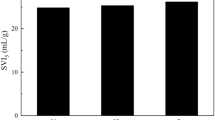Abstract
When operating an activated sludge model (ASM), organic matters among input data criteria including pH, temperature, sludge retention time, and many more, can be categorized to its own characteristics. Such category includes chemical oxygen demand (COD) and biochemical oxygen demand. However, these are not likely to represent benchmark criteria meeting the conditions required by ASM. In this study, experimenting piggery wastewater and an anaerobic digester supernatant from municipal wastewater treatment plants (MWTPs) with the use of the microbial respirometric method, the true categories for organic matters were implemented and assessed for the requirements of ASM. It was found that piggery wastewater was categorized with biodegradable organic matters with high content of slowly biodegradable COD, while anaerobic digester supernatant was mostly composed of non-biodegradable organic matters in high content of inert COD. When the COD fraction ratio discovered in this study is applied to an ASM for an accurate monitoring of a treating process of piggery wastewater and anaerobic digester supernatant, the findings could make a useful database in designing a biological treatment process and operating it in MWTP.






Similar content being viewed by others
References
APHA (American Public Health Association) (1998) Standard methods for the examination of water and waste water, 20th (edn), Washington, DC
Bortone G, Cech JS, Germirli F, Bianchi R, Tilche A (1993) Experimental approaches for the characterisation of a nitrification/denitrification process on industrial wastewater. Water Sci Technol 29(7):129–136
Choi YG, Kim KD, Kim HJ, Kim YJ, Jung TH (2003) Respirometry for COD fractionation of wastewater. J Korean Soc Water Wastewater 17(4):503–509
Dircks K, Pind PF, Mosb KH, Henze M (1999) Yield determination by respirometry—the possible influence of storage under aerobic conditions in activated sludge. Water SA 25(1):69–74
Gil KI (2006) Nitritation of anaerobic digester supernatant from sludge processing in MWTP. J Korean Soc Water Qual 22(3):540–545
Gil KI, Rho HY, Kim DI, Michael KS (2012) Comparison of bio-P module and the modified bio-P module in the step-feed biological nutrient removal process. Environ Earth Sci 65:929–936
Hong JY, Shin EB, Kim YK, Kim BJ (2003) Evaluation of the changes of microbial biomass fraction using OUR measurement. J Korean Soc Water Qual 19(4):445–454
Im JY, Gil KI (2011a) Evaluation of nitritation of high strength ammonia with variation of SRT and temperature using piggery wastewater. J Korean Soc Water Qual 27(5):563–571
Im JY, Gil KI (2011b) Effect of anaerobic digestion on the high rate of nitritation treating piggery wastewater. J Environ Sci 23(11):1787–1793
Ince O, Babuna FG, Kasapgil B, Anderson GK (1998) Experimental determination of the inert soluble COD fraction of a berwery wastewater under anaerobic conditions. Environ Technol 19(4):437–442
Kim DH (2007) Presumption of nitrogen compound of nitritation of sewer by the respirometric method. J Korean Soc Water Wastewater 21(3):295–303
Metcalf and Eddy (2001) Wastewater engineering, 4th edn. Mcgraw Hill, New York
Roh HY (2006) Optimization of operational conditions of existing BNR process using simulation method, Dissertation, Seoul National University of Science and Technology
Roh HY, Gil KI (2007) Modeling of existing BNR process using ASM3 and modified bio-P module. J Korean Soc Water Qual 23(3):309–313
Samson KA, Ekama GA (2000) An assessment of sewage sludge stability with a specific oxygen utilization rate (SOUR) test method. Water Sci Technol 42(9):37–40
Tong L, Wang Y, Li P, Wang J, Shao Y (2010) Headspace solid-phase microextraction (HS-SPME) and solid-phase extraction (SPE) concentration for quantification of malodorous substances in piggery wastewater. Environ Forensics 11(4):355–362
Wentzel MC, Dircks A, Pind PF, Mosb KH, Henze M (1999) Yield determination by respirometry—the possible influence of storage under aerobic conditions in activated sludge. Water SA 25(1):69–74
Acknowledgments
This work was funded by the National Research Foundation (NRF) of a grant program from the Korea government (MSIP) (No. 2013R1A2A2A01068579).
Author information
Authors and Affiliations
Corresponding author
Rights and permissions
About this article
Cite this article
Im, J., Kim, D. & Gil, K. COD fraction analysis of anaerobic digester supernatant and piggery wastewater, using respirometric method. Environ Earth Sci 75, 47 (2016). https://doi.org/10.1007/s12665-015-4868-7
Received:
Accepted:
Published:
DOI: https://doi.org/10.1007/s12665-015-4868-7




